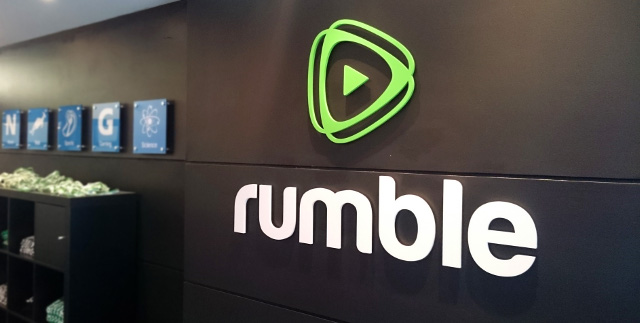Welcome to the world of Rumble.com! If you’ve been exploring video platforms, you might have stumbled upon Rumble. But you might be wondering, “Is this platform really legitimate?” In a crowded space of video-sharing websites,
History and Background of Rumble

Rumble was founded in 2013 by Chris Pavlovski, with a vision to create a platform where anyone could share videos freely and earn from their content. The site gained traction as an alternative for those who felt restricted by the policies of larger platforms like YouTube. Rumble started out focusing primarily on user-generated content, allowing creators to upload videos on various topics, from entertainment to education.
Initially, Rumble struggled to compete with established players. However, it began gaining attention in 2020 as content creators and viewers sought new options for video sharing, particularly amid rising concerns over censorship on mainstream platforms. This shift in public sentiment gave Rumble an opportunity. The platform positioned itself as a haven for free speech, appealing to a diverse user base.
One of the pivotal moments in Rumble’s history was its partnership with various content creators. The platform introduced a monetization model that encouraged users to share their videos in return for revenue. Creators could earn money through views, and Rumble offered a competitive pay structure compared to other platforms. This attracted a range of creators, from independent journalists to viral video makers, all looking for a fairer system.
By 2021, Rumble had solidified its presence in the video-sharing market, especially among conservative and independent creators who often felt sidelined by mainstream platforms. It became known for promoting videos with narratives that diverged from the typical media discourse, making it a go-to spot for a different kind of audience.
As Rumble continued to grow, it also expanded its functionalities. The platform improved its user interface, focusing on ease of use and accessibility. Features like live streaming and video monetization became more robust, attracting even more content creators. This evolution helped Rumble shift its image from a small player to a serious contender in the video industry.
With a focus on community and creator support, Rumble hosted various initiatives, encouraging users to engage with each other and share content across different networks. This helped foster a sense of belonging among users, further solidifying Rumble's reputation as a legitimate platform for video sharing.
Today, Rumble stands as a unique player in the vast landscape of video platforms, boasting a diverse range of content while promoting creator freedom. As the platform continues to evolve, it remains to be seen how it will adapt to changing trends and viewer preferences. But one thing is clear: Rumble has made its mark and is here to stay!
Also Read This: Did Zeke Survive the Rumbling? Understanding Zeke’s Fate in the Story
3. Understanding Rumble's Business Model

Rumble.com has emerged as a fascinating player in the video-sharing landscape, particularly for content creators looking for alternatives to mainstream platforms like YouTube. But what exactly drives Rumble’s operations? Let’s dive into its business model!
At its core, Rumble operates on a straightforward premise: it allows creators to upload their videos and earn money from them, but with a few unique twists. Here’s how it works:
- Monetization Options: Rumble offers various monetization strategies. Creators can earn revenue through ads, sponsorships, and even licensing their videos to media outlets. This flexibility makes it appealing for diverse creators, from vloggers to news commentators.
- Revenue Sharing: Unlike some platforms that take a hefty cut, Rumble has a more creator-friendly revenue-sharing model. Typically, creators keep a larger portion of the ad revenue, which can be particularly enticing for those looking to make a living off their content.
- Partnership Programs: By participating in Rumble's partnership programs, creators can boost their earnings even further. These programs often provide additional promotional opportunities, helping creators reach a broader audience.
Rumble also focuses heavily on user engagement and community building. With features like trending videos and user recommendations, the platform encourages viewers to discover new content and creators to engage with their audience actively. This community-driven approach not only helps in retaining users but also fosters a sense of belonging among creators.
Moreover, Rumble has carved a niche for itself by promoting free speech and allowing content that some mainstream platforms might restrict. This commitment has attracted a specific user base, particularly those who appreciate a more open platform for diverse viewpoints.
In summary, Rumble's business model is all about empowering creators, offering them the tools and opportunities to monetize their content while fostering a vibrant community. Whether you're a casual content creator or someone looking to grow a substantial audience, understanding this model is key to determining if Rumble is the right fit for you.
Also Read This: How Many Views Do You Need to Get Paid on Rumble? A Guide to Monetization
4. Evaluating the Credibility of Rumble.com
When considering a video platform like Rumble.com, evaluating its credibility is essential. After all, you want to ensure that your content is hosted on a reliable platform that values both creators and viewers. Here are some factors to consider:
- Transparency: Rumble is quite transparent about its operations, including how it handles revenue sharing and content moderation. This transparency builds trust with users, as they know what to expect when they join the platform.
- User Reviews: Checking user reviews and experiences can give a clearer picture of Rumble's reputation. While opinions may vary, a general trend of positive feedback often indicates a trustworthy platform. For instance, many creators praise Rumble for its supportive community and the ability to generate income.
- Partnerships and Collaborations: Rumble has partnered with various companies and media outlets, enhancing its credibility. Such partnerships often signify that a platform is recognized and respected within the industry.
- Content Moderation Policies: Understanding how Rumble handles content moderation is crucial. The platform promotes free speech, but it also has guidelines to manage harmful content. Evaluating how effectively these policies are enforced can help gauge its credibility.
Another aspect to consider is the engagement level of the user base. A growing and active community often indicates that a platform is resonating well with its users. Rumble has seen significant user growth, particularly among those seeking alternative viewpoints, enhancing its credibility as a platform for diverse content.
In conclusion, while Rumble.com presents itself as a legitimate video-sharing platform with unique opportunities for creators, it's essential to conduct thorough research. By assessing its transparency, user feedback, partnerships, and content policies, you can better determine if Rumble is a credible choice for your video content journey.
Also Read This: What Is Super Rumble on Instagram Reddit? Explaining the Instagram Trend
5. User Experience and Content Quality on Rumble
When diving into Rumble.com, the user experience is surprisingly pleasant. The platform boasts a clean interface that makes navigation straightforward, even for those who might not be tech-savvy. Think of it as stepping into a cozy coffee shop rather than a bustling city square—everything is easy to find, and you're not overwhelmed by flashy distractions.
One standout feature is the search functionality. Users can quickly locate videos by entering keywords, and there’s also a trending section that showcases popular content. This feature helps you stay in the loop with what’s currently capturing viewers' attention.
Regarding content quality, Rumble has a mixed bag. You will find some gems, such as informative tutorials, engaging vlogs, and even some exclusive content that you won’t find on other platforms. However, there’s also a fair share of low-quality uploads—think poorly shot videos and misleading titles designed to grab clicks. It’s essential to sift through the clutter to find what truly resonates with you.
In terms of engagement, Rumble fosters a community vibe. The comment sections can be lively, filled with discussions and debates about the videos. This level of interaction can enrich your viewing experience, making it feel more like a conversation than a one-sided lecture.
To sum it up, the user experience on Rumble is generally positive, but the quality of content can vary widely. Here’s a quick list of pros and cons:
- Pros:
- Intuitive and user-friendly interface
- Effective search and trending features
- Community engagement through comments
- Cons:
- Inconsistent content quality
- Some videos may lack production value
- Finding valuable content requires some effort
Also Read This: Why Rumble Is Becoming a Popular Video Platform Globally
6. Comparing Rumble with Other Video Platforms
When you stack Rumble against giants like YouTube or Vimeo, it’s clear each platform has its unique flavor. Let’s break down some of the key differences and similarities to give you a better sense of where Rumble stands.
Content Focus: Rumble seems to thrive on a mix of independent creators and alternative viewpoints. Many users flock to it for content that they believe isn’t adequately represented on mainstream platforms. In contrast, YouTube is often seen as the go-to for polished, mainstream content, from music videos to high-budget documentaries.
Monetization: One of the most attractive features of Rumble is its monetization model. Creators can earn money through views, making it appealing for those starting out. YouTube has a more established monetization program but is often criticized for its strict eligibility criteria and complex algorithms that can affect earnings.
Censorship and Content Moderation: Rumble promotes itself as a free-speech platform, often positioning itself against what it perceives as censorship on other sites. If you’re someone who values freedom of expression, Rumble might seem like a refreshing alternative. On the flip side, YouTube has a more rigorous content moderation policy, which some users feel stifles creativity or diverse opinions.
Here’s a quick comparison table:
| Feature | Rumble | YouTube |
|---|---|---|
| Content Focus | Independent creators & alternative views | Mainstream content & diverse creators |
| Monetization | Earnings through views | Complex ads & subscription models |
| Censorship Policy | Promotes free speech | Strict content moderation |
In conclusion, Rumble offers a unique platform for those seeking alternative content and creator-friendly monetization. While it doesn't quite match the polish and reach of YouTube, it definitely fills a niche that many users find appealing.
Also Read This: Dan Bongino on Rumble: What to Know
7. Pros and Cons of Using Rumble.com
When considering whether to dive into Rumble.com, it’s essential to weigh the pros and cons. Like any platform, it has its strengths and weaknesses that can influence your experience and decision-making.
Pros
- Monetization Opportunities: Rumble offers various ways for creators to earn money, whether through ad revenue, licensing deals, or subscriptions. This can be a great incentive for content creators looking to make a living.
- Support for Diverse Content: Unlike some platforms that enforce strict content guidelines, Rumble embraces a wider range of content, making it a haven for creators with unique voices and perspectives.
- User-Friendly Interface: Rumble’s interface is straightforward, allowing even the most technologically challenged users to upload and share videos easily. This accessibility helps new creators get started without a steep learning curve.
- Growing Audience: Rumble is gaining traction, attracting viewers looking for alternatives to mainstream platforms. This growth can lead to a larger audience for your videos.
- Community Engagement: Users on Rumble often engage actively with content, forming a tight-knit community where creators can receive direct feedback and foster connections with their audience.
Cons
- Smaller User Base: Compared to giants like YouTube, Rumble’s user base is still relatively small. This means that while your content may reach a dedicated audience, it might not achieve the same visibility as on larger platforms.
- Content Moderation Concerns: With fewer restrictions, some users may post content that is controversial or misleading. This can affect the platform's reputation and make it less appealing to advertisers.
- Monetization Challenges: While there are monetization opportunities, they may not be as lucrative or straightforward as those found on established platforms. Creators might need to navigate different contracts and terms.
- Less Discoverability: The algorithm on Rumble may not be as refined as those on larger platforms, potentially making it harder for new creators to get discovered.
- Technical Issues: Some users have reported occasional technical glitches or slow loading times, which can be frustrating when trying to upload or stream content.
In summary, Rumble.com has a lot of potential for content creators, especially those looking for alternative platforms. However, it’s crucial to consider these pros and cons to determine if it aligns with your goals and content style.
8. How to Get Started on Rumble
Ready to take the plunge into Rumble.com? Getting started is easier than you might think! Here’s a simple step-by-step guide to help you kick off your journey as a video creator on Rumble.
Step 1: Create Your Account
First things first, you’ll need to sign up. Head over to Rumble.com and click on the “Sign Up” button. You can create your account using an email address, or you can opt for social media login options like Facebook or Google.
Step 2: Set Up Your Profile
Once your account is created, take a moment to complete your profile. Include a profile picture, a brief bio, and links to your other social media accounts. This helps build your brand and makes it easier for viewers to connect with you.
Step 3: Understand the Guidelines
Before uploading content, familiarize yourself with Rumble’s content guidelines. This will help you avoid any pitfalls and ensure your videos align with the platform’s standards.
Step 4: Create and Upload Your First Video
Now comes the fun part! Create a video that reflects your interests or expertise. Whether it’s a vlog, tutorial, or commentary, make sure it’s engaging and high-quality. Once you’re ready, click on the “Upload” button, select your video file, and fill in the necessary details like title, description, and tags.
Step 5: Promote Your Content
Don’t just sit back and wait for views! Share your videos on social media, engage with your audience, and collaborate with other creators to expand your reach. Consider joining Rumble-related groups on platforms like Facebook or Reddit to connect with other creators and share your work.
Step 6: Keep Creating!
Consistency is key in the world of video creation. Keep producing content, engage with your audience, and explore new ideas. The more you create, the better you’ll become!
By following these straightforward steps, you’ll be well on your way to establishing yourself on Rumble.com. Remember, every creator starts somewhere—embrace the journey and have fun along the way!
 admin
admin








